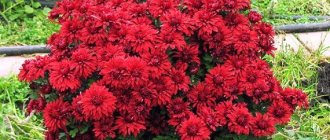Garden rose: how to grow a luxurious bush
Existing on Earth since the time of dinosaurs, the rose has always aroused the delight of poets and the awe of gardeners, striking the former with its exquisite beauty and the latter with its amazing species diversity.
The number of species of this beautiful representative of the Shipovnikov genus is in the hundreds, and the varieties are in the thousands. The warm and temperate latitudes of the Northern Hemisphere are considered the homeland of wild roses, which are often in no way inferior to their cultivated garden varieties. Modern cultivated species are represented by park and garden roses, of which the most common are bush, hybrid tea, polyantha, ground cover and climbing species, as well as floribunda and grandiflora roses. Each species deserves special attention, but within the framework of the article we will look at the features of agricultural technology for growing bush garden roses, learn the rules for planting and propagating them.
How to care for garden roses
Homemade Achimenes flowers - care and cultivation
Caring for garden roses requires careful attention to the structure of the soil. We offer you some rules on how to care for roses. Roses, like most other garden plants, place high demands on the supply of nutrients in the soil. If they lack one or more vital elements, then signs of starvation appear on the leaves or flowers, which affects their decorative properties. The standard way to avoid this is to sprinkle a small handful of rose fertilizer around each plant in the spring, when the soil is moist. Use a hoe to mix the fertilizer into the soil.
The value of mulching has already been described several times in the previous pages of the book. The right time for mulching is May or June. The main purpose of loosening the soil with a hoe is to suppress weeds, such as wheatgrass, that are not controlled by mulching. To achieve this, loosening must be carried out at frequent, regular intervals. The hoe should not go more than 2-3 cm below the soil surface, otherwise the roots of the roses may be damaged.
One of the advantages of roses is their deep root system. This means that watering established plants is not vital in certain seasons. Some roses, however, may need watering after a week of dry weather in summer - newly planted roses, vines growing near walls, and bushes in sandy soil. However, during a prolonged period of drought, all roses will need watering.
There is, unfortunately, a duo of fungal diseases that disfigure roses - black spot with its dark spots with a yellow edge on the leaves that fall prematurely, and powdery mildew, which covers the leaves, shoots and buds with a white coating. Many roses from the Rambler and Shrub groups have little or no immunity, and it is always advisable to check the resistance of roses to disease before purchasing.
Regularly removing faded flowers from hybrid tea and floribunda roses is an important task. When the petals have fallen, remove the entire cluster by cutting off the stem just above the second or third leaf. Wilted flowers in the first year of a rose's life should be removed with a very small portion of the stem.
Description of species
Various species of this crop form bushes of various shapes - from compact and narrow pyramidal to wide and spreading. The height of the rose bush also depends on the species and varies from 0.25 to 3 meters.
The leaves are dark green, dense, odd-pinnate with a serrated edge. The peduncle reaches from 0.1 to 1 m, the flowers are of different sizes - from 2 to 18 cm in diameter, surprising in the variety of shapes and colors. Depending on the variety, they can have 5 or 120 petals, be single or part of an inflorescence consisting of a different number of flowers (from 3 to 200).
Flower shape plays a role in the formation of species. There are pompom, flat, peony, saucer, bowl, cone, spherical and other roses. The color of the buds evokes the admiration of not only amateurs, but also professionals: these colors combine all the colors of the world, except ultramarine shades.
Buying a bush rose
A lot, if not everything, depends on the quality of the seedling. Of course, if you buy a diseased plant, nothing worthwhile will come of it. Additionally, many factors are taken into account: soil characteristics, rose variety, climatic conditions of the region, and the need for additional care.
It remains to clarify some points:
- In the store/market there are grafted seedlings or on their own rhizome. You need to know this in order to understand which plant the cuttings took root on.
- Age - experts recommend taking young animals from 2 to 3 years old. He is strong and will definitely survive the coming winter.
- The seedling on its root is weaker in development and needs a long period of adaptation, building up the system underground. Such flowers require special care during the first year of existence in a new place. They often die at the first frost.
- A bare-root rose should have a few stems that are completely woody and the rest fresh and uniform. No wrinkled structure - this indicates drying out and even some diseases.
- Healthy plant: without spotting, with well-developed roots and stems, buds in a dormant state.
Important! The exposed root system must be disinfected.
The need for long-term transportation of a seedling determines the appropriate conditions: the root is in water or wrapped in a damp rag, the shoots are in wet paper, and the entire seedling is in polyethylene. A week can pass in this state without harming the health of the rose.
Features of agricultural technology
Before you start cultivating roses, you need to take a closer look at the requirements of this elegant queen. In addition, you will have to come to terms with the thorns that spray roses are strewn with.
Advice! Growing roses is greatly facilitated if varieties are initially selected that are adapted to the climatic conditions of the area. This will ensure good survival rate, high-quality development and generous flowering.
But even the hardiest varieties will need shelter for the winter, formative and sanitary pruning, timely feeding and traditional care. Let's talk about the intricacies of planting.
When and how to plant roses
The best planting time is considered to be the first half of autumn. It is during this period that strong, viable seedlings arrive from nurseries.
Important! Purchased seedlings are carefully inspected, broken or rotten roots are removed, and a moist environment is provided for short-term storage. A good option for purchasing is a plant in a container (with a protected root system).
Rose is a lover of open spaces, bright sunshine and elevated places. Areas without a close approach to groundwater with fertile, water- and breathable slightly acidic soil (pH 6-6.5) are considered optimal for it.
Landing technology
Before planting a rose, you should shorten the stems to 15-20 cm and immerse the roots in water for several hours. When digging a planting hole, they focus on the grafting site - a characteristic thickening. It is buried 5 cm when planting. The diameter of the hole is 40-50 cm. Add high-quality humus or compost (one-third of the volume of soil), a glass of ash to the dug soil and mix.
A bucket of water with the addition of aloe juice or heteroauxin is poured into the hole, the seedling is placed and gradually sprinkled with prepared soil.
Important! To avoid the formation of air pockets that have a detrimental effect on the roots, the seedling is periodically shaken during planting and the soil is compacted.
When the planting of roses is finished, the plant is hilled up high, then watered again. Plants are planted at intervals of 1-1.5 m, focusing on the variety. For better rooting, the seedling is watered moderately every 2-3 days. When the first shoots appear, the soil with which the plant was hilled up is raked off, and the soil is mulched with wood chips or humus. Autumn plantings are completely covered with soil for the winter.
The best period for planting roses in spring is from late April to late May.
Caring for the Queen of the Garden
In the first year after planting, the bush is just beginning to form, so it is necessary to stimulate branching by pinching the tips of the shoots and removing emerging buds, since the flowering of the rose will significantly weaken the plant.
Shrub roses develop quickly and do not cause the hassle that usually accompanies the cultivation of standard or climbing varieties.
Watering
Roses require moderate watering, with the exception of the first year, when the plant takes root and adapts. Practice infrequent but abundant watering. With the beginning of spring, when the plant begins to grow, watering is intense, in the summer - moderate, oriented to weather conditions. During dry periods, the bush is moistened more often; in rainy times, nature will take care of it itself.
Advice! The best way to avoid eroding the soil above the graft is drip irrigation with warm water, and the best time for watering is in the morning, before the heat sets in, or in the evening, but not late.
Feeding
This delicate flower requires regular feeding, which should begin in the second year after planting. During the season, the rose should receive four feedings:
- the first in two stages - in the spring after pruning the bush, ammonium sulfate is applied 20g/1 m2, after 2 weeks the fertilizing is repeated;
- the second – during the budding period 30-40 g. universal "Kemira" per 1 m2;
- third - after flowering 30 gr. complex fertilizers with microelements per 1 m2;
- fourth - in September, phosphorus-potassium fertilizers are applied (30 g / 1 m2).
Advice! You can successfully replace mineral fertilizers with high-quality organic matter - manure, bird droppings, ash.
Trimming
Caring for roses also includes annual pruning - a very labor-intensive procedure. They are carried out:
- in spring, forming a bush and stimulating branching, growth of stems and peduncles;
- in summer, cutting out dried buds and unnecessary fruits;
- in the fall, preparing the bush for wintering and removing weak shoots that draw food onto themselves.
Article on the topic: Dendrobium orchid: care at home, photos, propagation, transplantation, after flowering
Spring pruning is carried out before the buds swell and the sap begins to flow. It is the main and most radical: all weak, broken or directed shoots towards the center of the bush are removed, giving the plant the desired shape.
Advice! When pruning roses, it is recommended to leave well-placed and younger stems, focusing on the color of the bark - the lighter it is, the younger the shoot.
In addition, to stimulate flowering, it is necessary to remove root shoots. Summer pruning is of a sanitary nature: the shoots are trimmed, leaving 2-3 growth buds on them, necessary for tillering. In autumn, all wilted or immature shoots are cut off from the bush. The sections are treated with garden varnish or pharmaceutical brilliant green.
Transfer
Rose bushes grow greatly, losing their decorative value, so replanting is inevitable. This can be done in spring or autumn. Experienced flower growers believe that spring transplants are more successful. The algorithm of actions is as follows:
- before transplanting, all shoots are cut off by 20 cm, weak and diseased branches are removed, and leaves are torn off;
- They dig up the bush along with the earthen clod and carefully transport it to the new planting site.
The crop is replanted according to the same rules that are followed when planting.
Shrub roses: care and cultivation
Throughout the first year, you need to pinch the ends so that the bush is as full as possible. The buds will have to be cut off immediately after they appear until mid-summer. Then all newly formed flowers are removed. Only under such conditions the plant will become strong and there will be no problems with growing in the future.
Reproduction by layering
The rose is very moisture-loving, but if it grows in lowlands, it can rot. Only planted bushes are watered every two days in dry weather. In spring, watering is abundant due to the active growth of young growth and foliage.
Systematic feeding is not necessary in the first year, but then fertilizer should be applied according to the following regime (per 1 sq. m):
- In the spring, with active growth - 20 g of ammonium nitrate and ammonium sulfate. Repeat after 2 weeks.
- During the formation of buds - 30 g of superphosphate per 30 g of ammonium nitrate and 10 g of potassium salt.
- After flowering and before the stems become woody - superphosphate and potassium salt (40 g).
As organic matter, roses love chicken droppings, slurry and wood ash.
Reproduction
There are many ways to propagate the crop - vegetative and seeds.
Growing from seeds
Breeders often resort to propagation by seeds to develop new species. Gardeners usually do not use this method, since roses grown from seeds do not inherit varietal characteristics. However, growing a rose from seeds is not difficult. The seeds are collected in August, cleaned and placed in a container with damp sand and stratified for 4 months at a temperature of 2-4ºC.
With the arrival of spring, seeds, pre-treated with any biostimulant, are sown, buried 1-3 cm. The crops are mulched with humus, and when the seedlings have 3-4 leaves, they are planted with an interval of 8-10 cm between plants and 20 cm between rows . In summer, seedlings are fed 2-3 times with complex mineral fertilizers, cared for by weeding and moderate watering. Next year, by the end of summer, the grown seedlings can be used as rootstock.
Vegetative methods
Propagation of roses by cuttings in park and indoor species is common. Cuttings are taken from flowering shoots, each of which must have at least 3 internodes. The lower cut of 1-1.5 cm is immersed in a container of water and placed in a sunny place. After 10-12 days, callus forms on the bottom of the cutting, which then turns into a light influx, indicating the readiness of the cutting for planting in a substrate consisting of a mixture of humus, peat, sand and turf soil (0.5; 1:1:1). After 7-10 days, buds sprout on the cuttings.
Shrub roses with their own roots are often propagated by dividing the bush, separating with a sharp knife parts of the roots with 1-3 shoots having 2-4 growth buds. The sections are powdered with crushed coal and planted.
Important! Only ungrafted roses can be propagated by dividing the bush. Polyantha roses and floribunda show the best adaptation after planting the cuttings.
But with the help of layering you can get excellent new bushes from any type of rose. They use shoots that sprout at the very root collar, making circular cuts on them, pinning them to the ground and sprinkling them. The top of the stem is left on the surface. She is tied to a peg, giving direction. By autumn the cuttings will take root, but it will be possible to cut them off from the main bush only next spring.
Diseases
Unfavorable conditions or improper care can cause rose diseases. More often, plants are affected by powdery mildew, rust, black spot, and chlorosis. Fungal infections are destroyed with fungicides, and chlorosis is an indicator of a deficiency of a chemical element in the soil, usually iron. In this case, a soil analysis and replenishment of the missing substance is necessary.
These are the features of agricultural technology for growing the most exquisite and beautiful garden crop - the bush rose. A little effort and following simple recommendations will allow you to change the garden interior, decorating the area with an excellent crop - the queen of the plant world.
Planting a bush rose
This gorgeous plant is planted both in spring and summer.
When planting in autumn, it is important to prune the seedlings and remove leaves.
Selecting a location
The most important thing before planting a bush rose is to choose a suitable place. The intensity of rose flowering will directly depend on this.
So, in particular, bush roses love the sun. Therefore, they must be planted in a sunny place on the site.
The place chosen for planting should not be blown by winds and be away from groundwater.
Soil preparation
The ideal soil composition will be that which allows moisture and air to pass through and is slightly acidic.
Such soil can be garden soil mixed with peat and bone meal.
Landing Features
Immediately before planting a bush rose seedling, it is necessary to inspect its roots. Those that are too long or damaged should be cut off.
If the roots are dry, they need to be kept in water for some time. In accordance with the size of the bush and its roots, you need to make a planting hole.
The roots should not be bent; they should look down. The root system is covered with prepared soil mixture, which is evenly distributed over the entire surface and slightly compacted.
The top layer of soil should be slightly loosened, and then the planted plant should be watered abundantly.
You can lay a layer of peat on top of the planting. When the bush rose gets stronger and grows a little, it should be hilled up and the soil mulched thoroughly.
Read about planting and caring for Thunberg barberry here.
If you want to know what mulching is, how and why to do it, read about it in the article https://greennirvana.ru/uchastok/pochva/mulchirovanie-chto-eto-takoe.html
Shrub roses - planting and care
In order for a bush rose in a dacha to become the owner’s pride, it needs to be planted on time. It is best to plant in the fall, from the beginning of September to the second week of October, the seedlings should be healthy. If you buy, it is also better in the fall, when they sell fresh material. It is very important to choose the right site.
It is necessary to take into account that:
- Rose loves sunny places.
- It should be planted away from houses and trees.
- The south or southeast is suitable; the flower does not like northern winds.
- Grows well in acidic, well-drained soils.
How to plant bush roses correctly?
When the place has already been chosen, you need to prepare the bush itself. Trim dry roots, but only with a sterile instrument. If they are very long, then shorten them. The branches should be left at 20 cm. Then the roots should be immersed in water for 3-4 hours. A hole for roses is dug 40 cm in diameter, and the depth should be 10 cm wider than the diameter of the rhizome.
Planting a bush rose:
- Loosen the bottom of the hole with a pitchfork.
- Dissolve a heteroauxin tablet in a bucket of water and pour it out.
- Mix the excavated soil with compost 3 to 1.
- Add wood ash.
- Place the seedling in the hole and fill it, lightly compacting each layer.
- Hill up to 15 cm in height.
- Make a cushion out of the soil to prevent water from flowing out.
- Shade for the first 10 days.
- You can water it for the first time after two days.
How to care for a bush rose?
Caring for bush roses requires special attention in the first year. They need to be watered every two days, using only room water. At this time, the bush is forming, so you need to remove the buds so that the forces go to the growth of roots and leaves. And already from mid-summer, the buds are removed only after formation.
Important Tips:
- In the spring, water more often while the leaves are forming.
- In summer, watering one bush takes about 10 liters of water.
- When the plant fades, the amount is reduced.
- The water should not “stand”, otherwise fungus may develop.
- Water in the morning or evening.
Pruning bush roses
A very important point is the correct pruning of the bushes, then the rose will grow well. In the spring, you need to remove excess branches and form a bush so that the branches do not interfere with each other. This is done before the buds swell. Pruning a bush rose in summer involves removing dry leaves and branches growing inside the bush.
How to feed a bush rose?
The optimal mixture is 2 parts of phosphorus fertilizers and 1 part of potassium and nitrogen fertilizers. It is necessary to remove the top layer of soil, lay down fertilizers and cover again, then the fertilizers will flow to the roots when watering. You can immediately buy liquid fertilizers that are diluted with water. In the first year of life, roses are not fertilized.
Feeding bush roses:
- The first is done in the spring, when the bush is growing.
- The second is when the buds appear.
- The third feeding is carried out when the rose stops blooming.
- The turn of the fourth feeding is in the process of lignification.
How to propagate a bush rose?
Planting a flower you like is not difficult if you follow the basic rules. Reproduction of bush roses is carried out in 2 ways: dividing the bush and cuttings. The first method is good in the spring, when the buds have not yet bloomed, or in early autumn. The second is convenient in July, when flowers appear and the plant takes root well.
Reproduction by dividing the bush:
- Dig up the roots, cut so that 2 stems or 2 buds and part of the roots remain.
- Plant and insulate with earth for the winter.
Propagation by cuttings:
- A cutting 8 cm long and as thick as a pencil is cut. The top is cut 0.5 cm above the kidney, and the bottom is cut just below the kidney.
- The top cut should be straight, and the bottom cut should be at an angle of 45 degrees.
- Plant at 15 cm depth.
- Fill it, compact it, insulate it with film, making holes in it.
- Pluck the first buds to strengthen the roots.
Reproduction of bush roses
Cuttings
Shrub roses are propagated in several ways, each of which will have its own characteristics.
The optimal way to propagate bush roses is cuttings, which are best done in August.
For cuttings you will need a healthy and strong rose bush, not damaged by diseases and pests. You need to choose mature and reliable shoots equipped with at least three leaves.
For the purpose of propagation, only the upper leaves are left on the shoot. Next, the cutting is planted in a container to its lowest point.
You should prepare a suitable container in advance with high-quality and fertilized soil poured into it. After planting the cutting, it must be watered well and covered with some kind of container.
Related article: Spiraea: planting and care in open ground, pruning and replanting
Reproduction by layering
Another popular method of propagating bush roses is propagation using layering, which is performed at the end of summer. For this purpose, soil containing peat is prepared. A strong and rooted plant with flexible long shoots is selected.
An incision is made at the bottom of the shoot, into which you need to insert a match and bury it with peat. To keep the shoot vertical relative to the ground, it should be tied to a support. After the tap produces a kidney, it needs to be transplanted.
You can also watch the video about growing and propagating bush roses:
Advantages and disadvantages
Bush varieties of decorative roses are extremely popular among gardeners, and there is a completely logical explanation for this. Or rather, several. This is dynamic flowering combined with plant growth, a delicate aroma, inflorescences collected from many buds.
See also
Description and characteristics of climbing rose variety Prince, growing rulesRead
Climbing and wattle varieties provide worthy material for bouquets and decorative compositions. In addition, in the overwhelming majority, bush varieties are distinguished by their resistance to cold, endurance, and resistance to diseases and pests.
But with these advantages, there are also disadvantages. The rose needs to be pruned, fed, and cared for. And there are still sharp, needle-like thorns protecting the buds. There is nothing complicated in the care itself; after learning the simple rules, even a beginner can cope with it.
Caring for a bush rose
Caring for a bush rose is not considered too difficult. It comes down to performing certain actions to keep the plant beautiful and healthy.
Top dressing
Feeding roses is one of the main aspects of care. Fertilizing should be given the closest attention.
Monthly feeding schedule for bush roses:
- In April, after preventive pruning, roses are fed with nitrogen, which is contained in ammonium nitrate, ammophoska and urea.
In addition to nitrogen-containing fertilizers, bush roses also take well to organic matter, including compost teas, which have a beneficial effect on the growth and development of plants and their root system. With the arrival of May, roses can be fed with spring Kemira, saltpeter, ammophic or urea, as well as organic matter.
To properly apply organic matter and, in particular, cow manure, a furrow is drawn with a hoe along the radius of the hole in which the rose bush grows, where the fertilizer is placed. If feeding has already been done in April, then roses should not be fed in May. In June, buds begin to form on the rose, so fertilizing must be done at least twice. For this purpose, solutions of mullein, horse manure, ash and chicken droppings are useful.
These solutions must be sprayed with a grassy corolla onto the leaves of rose flowers in the evening. Foliar feeding is also carried out with infusions made on the basis of potassium fertilizers, which include saltpeter and potassium magnesium. In July, after the roses have finished flowering and the buds have been trimmed, the plant needs feeding.
For this purpose, universal fertilizers are used. You can also add liquid organic matter from manure, litter and compost. A nettle infusion would be good. However, from all of the above, it is worth choosing one thing.
- In August, the bush rose is fed for the last time. Feeding is carried out with phosphorus and potassium separately, bromine, iron, molybdenum, zinc, as well as microelements so that the rose can prepare for winter and meet it in a healthy state.
- With coming September The main autumn fertilizer is phosphorus, which is applied to the soil in the form of superphosphate.
At this time of year, it is strictly not recommended to add nitrogen to the soil, as this will prevent the rose from going dormant for the winter. Potassium fertilisers, which are quickly absorbed by the rose, will not hurt, helping to strengthen it before the upcoming cold weather.In rainy and cold weather, it is better to give the rose foliar feeding, which will improve the general condition of the plant and increase the size and number of flowers.
Pruning a bush rose
Regular pruning of a bush rose allows you to maintain its charm, as well as to properly shape the bush as it grows.
The best time to carry out the main pruning of a bush rose is early spring - the moment the buds swell.
Weak and damaged branches are subject to pruning, as well as those branches that will interfere with others that have a better location on the bush.
Proper pruning of a bush rose regulates its flowering. The longer the remaining part of the branch, the more flowers there will be on it.
When pruning in spring, you should pay attention to the buds of the bush rose. If, for example, the upper buds are frozen in the harsh winter and do not wake up, then they should be removed until the buds are well swollen.
To maintain the beauty and health of a bush rose, it is necessary to prune it regularly.
Shrub roses require some care even in summer. It is imperative to remove dried shoots with branches and fallen flowers with peduncles.
It is necessary to control the growth of the crown of a bush rose. In particular, blind shoots should be cut out so that the crown is well ventilated and there is no reason for the development of diseases.
It is also worth removing too long shoots that stand out from the general outline of the crown. This can be done at the moment when the flowers on these branches begin to crumble.
It is necessary to regularly remove fallen petals and leaves, which quickly rot and can contribute to the development of various diseases, making the bush sloppy.
Watering
Shrub roses love abundant watering, which is best done early in the morning or in the evening when the sun sets. It is important to control the watering process, since if drops of water are on the leaves, there is a chance that the bush rose will get sunburn.
Preparing a bush rose for winter
When preparing a bush rose for winter, you should do the final cleaning of flower beds with roses, weeding and loosening them. Immediately before wintering, roses can be treated with fungicides and sprinkled with ash to prevent rot and disease.
After all the work has been completed, the bush rose is prepared for shelter for the winter.
This activity is done in two ways: the bush is cut to the height of the shelter or the branches of the rose are bent to the ground.
In the first case, the work associated with pruning is reduced, and in the second case, a large volume of the bush is preserved, which ultimately leads to abundant and earlier flowering.
If you want to learn about the features of growing hydrangeas in Siberian conditions, click here.
You can also read about popular varieties of freesia, its planting and care.
Care Tips
A set of recommendations for caring for a rose includes advice on how to plant a cutting, how best to propagate it, how to cover it for the winter, and what to feed the plant for full flowering. How quickly the rose will take root in a new place and how it will feel in the future depends on the systematic implementation of them.
How to water correctly
The rose does not particularly need moisture; rather, it painfully tolerates increased watering. The following method has been determined empirically: water rarely, but abundantly. Newly sprouted seedlings especially need moisture; they are watered at intervals of 2 days. This life support scheme is used during the first year of the plant’s existence. In spring, more moisture is consumed, at which time leaves and young shoots form.
They do the same in the summer, especially in hot climates. Approximate proportions are 10 liters of water per rose bush. The liquid should get into the root zone, while the shoots themselves should not be exposed from the earthen clod. Watering with cold water is unacceptable, only with warm and, preferably, settled water. At the end of the season, when the growing season ends, the flow of liquid is reduced to protect the rose from possible stagnation and fungal development.
Feeding activities
The bush rose is an ornamental plant, more so than its wild ancestor, which needs a supply of nutrients. It is recommended to start active nutrition from the second year, using the following step-by-step algorithm:
- Double the dose of fertilizer applied in the spring.
- The appearance of cones, the development of buds on the bush.
- Completion of flowering.
- Transition of stems from plant to woody state.
It is permissible to combine spring pruning of roses with the application of fertilizers. A mixture of ammonium nitrate and ammonium sulfate is suitable for this. After about 15 days, fertilizing is repeated. To stimulate the ovaries, a complex consisting of superphosphate, nitrate and potassium salt is used, in approximately a ratio of 3:3:1 per square meter of planting. Sometimes such a composition is replaced with a ready-made one - Kemira Universal or similar.
Upon completion of flowering, it will be necessary to restore the balance of minerals; for this, fertilizing with microelements will be useful. At the end of July, the rose is placed on a nitrogen-free diet, stopping the supply of this type of fertilizer. It is allowed to replace mineral mixtures with organics (or their alternate use). Gardeners use burnt ash, manure or bird droppings.
Features of transplantation
Replanting bushes is a normal procedure practiced by gardeners. This is done for several reasons, including due to the natural growth of the rose. The optimal period for replanting is spring or autumn. Moreover, the spring period is preferable.
Before the procedure begins, the bush is freed from diseased, weak, damaged shoots, as well as foliage. The stems are also trimmed to 20-30 centimeters. Excavation from the ground is carried out carefully, trying not to damage the roots. Sometimes it makes more sense to transplant together with a soil ball.
Warm water is poured into a pre-dug hole, abundantly saturating the soil with moisture. The grafted rose bushes are placed so that the scion is covered with a layer of soil of 3-5 centimeters.
Rules for pruning
The main purpose of pruning is to force the rose to actively develop, produce fresh shoots, form lashes and buds. There are 3 periods for the procedure: spring, summer and autumn. First, this is necessary to form a rose bush, then to ensure the growth of shoots.
See also
Characteristics and description of Abraham Derby roses, cultivation and careRead
To do this, all small buds are mechanically removed, leaving a few large ones. In the fall, before the cold weather, the final stage is carried out: damaged parts of the plant and dead shoots are cut off from the rose.
How to prepare a bush rose for winter
The process of pruning bush roses for the winter consists of gradually reducing the amount of incoming moisture (in August), then adding an autumn nutrient complex of fertilizers. The lower leaves are cut off in September, the remaining leaves in October. Before sheltering and hibernating, the rose bush is shortened by removing shoots and stems.
“Wintering” depends on the climatic zone and peak temperatures. They often build a shield pyramid house over the bush, stretching a thick film over the top. If it is not possible to construct such a structure, construct a simpler shelter from film (thick paper), leaving a small gap between the protection and the plant. Sometimes a layer of snow is thrown on top (in severe frosts).
Control of pests and diseases of bush roses
The fight against pests and diseases of bush roses should begin with preventive measures that are carried out throughout the year.
These include weeding and pruning bush roses, their timely and sufficient watering, applying the necessary fertilizing, as well as proper preparation for winter.
Of the diseases, the greatest danger to bush roses is fungal diseases. To avoid them, you should choose a planting site without high humidity, with high groundwater, without drafts, and not darkened.
If a fungal disease is still able to affect the bush rose, then the rotten shoots and roots should be removed and the rose should be transplanted to a more suitable place. Also, during winter storage of seedlings in unventilated and damp areas, there is a high probability of developing fungal diseases.
If the rules for sanitary pruning of a bush rose are not followed, there is a high probability of its death. Therefore, before spraying with chemicals against diseases, you should promptly remove branches, buds and leaves already infected with the disease. This will help avoid further infection of healthy parts of the plant and neighboring bushes.
Article on the topic: Eustoma: planting and care in the open ground and at home
Rust damage to bush rose leaves
Diseases of bush roses also include black spot, powdery and downy mildew, anthracnose, gray mold, rust, and cercospora. In the fight against these and other diseases, various drugs will be effective, including fungicides that are optimally suited to the local climate and recommended by flower growers.
In the fight against pests, it is important to control their appearance on the bush rose and timely countermeasures.
The most common pest is aphids . If there are small colonies, the aphids are washed off with soapy water. If aphids are widespread, it is recommended to use insecticides and special preparations.
Pests of bush roses include chewing pests such as beetles and caterpillars, as well as sawfly larvae. Spider mites and cicadas can also cause great damage to a bush rose.
Description of a bush rose
Shrub roses can have a bush from a narrow pyramidal to a spreading form. The height of the shrub depends on the species. One can be from twenty-five centimeters to three meters, and sometimes higher. The bushes have main branches and young shoots. The leaves of the plant are odd-pinnate, ovate or elliptical in shape. The edge is serrated, there are two more leaf-like stipules. Flowers can be of various shapes and colors, and are quite large. The peduncle can grow from 10 cm to 80 cm. The name of the rose depends on the shape of the flower. For example, peony-shaped, cone-shaped, cup-shaped, pompom-shaped, flat, spherical, saucer-shaped and others. As for the colors of bush roses, they can be of various shades and their combinations of absolutely all colors, except bright blue. Roses with flowers of this color have not yet been bred. There are also roses whose color changes throughout the season. In addition to their varied shapes and colors, roses have incredible scents.
Varieties
Shrub roses do not have a strict classification. All of them belong to the scrub group and are distinguished by their bright colors of various shapes, unpretentiousness, aroma, long-term abundant flowering, and resistance to frost.
Popular varieties of bush roses include English roses, which were created by breeder David Austin.
Very popular among English roses are varieties such as Abraham Darby , Graham Thomas and the Burghausen , which is widely used for single plantings, reaching a height of two meters.
Canadian roses are famous for their frost resistance .
With good shelter, they can withstand temperatures down to -40 degrees Celsius.
The Canadian rose family includes roses from the Explorer Roses and Parkland Roses . Morden Centennial variety is considered one of the most beautiful types of Canadian roses. Its crimson double flowers with a diameter of 7-10 cm have up to fifty petals in their buds.
Shrub roses Morden Centennial
Ground cover roses have long shoots. They are able to create a beautiful flowering carpet. They are widely used to decorate arbors and arches.
Due to their abundant continuous flowering, they are popular for landscape decoration.
Varieties of bush roses
There is a wide variety of varieties of bush roses; their main difference is in color. The following varieties of bush roses are distinguished:
- white (“Porcellino”);
- pink, pale pink (“Bombastic”, “Red Eden”, “Yana”);
- red, burgundy (“Piano Red”, “Lydia”);
- orange (“Lambada”, “Freesia”);
- dark burgundy, with black petals (“Black Prince”, “Baccarat”).
The use of bush roses in landscape design
Shrub roses will certainly be able to decorate the landscape. They will give their owners shade on a hot day. Shrub roses, thanks to the variety of colors, shapes and aromas of flowers, will truly give the garden a unique look.
So, for example, the varieties Hansaland and Robusta are most suitable for creating hedges. Mozart and Lupo also look very impressive , which will be distinguished by their semi-double flowers. Their flowering is so abundant that the flowers will almost hide the foliage of the bush.
If the area allows, then bush roses can be planted in groups of three to five bushes. When the plants mature, they will create the impression of a huge blooming ball.
Diseases and pests of bush roses
Even under good conditions and proper care, roses need protection from diseases and pests. The most common ones are:
- Black spot. This disease looks like this - unsightly dark brown, gray spots on the foliage. This disease can be prevented by using a fungicide specifically formulated for use on roses during periods of cool, wet weather. Also, to avoid this disease, do not plant roses too close to each other, and make sure that they have enough sun, and when watering it is important to try to avoid getting water on the foliage.
- Powdery mildew. It looks like gray or white fuzzy spots on the leaves. A fungicide is used to prevent it. To avoid this, it is important to plant the rose in well-ventilated and sunny areas of the garden.
- Japanese beetles. These insects can eat almost all the foliage and flowers from a rose plant in just a couple of days. In the case of a small number of beetles, they are selected by hand and placed in soapy water. If the infestation is significant, garden insecticides containing carbaryl or permethrin are sprayed.
- Aphid. It is a tiny insect present in entire colonies on rose bushes. If they are small, it is enough to remove them with a strong stream of water from a hose. For larger infestations, a garden insecticide containing carbaryl or permethrin is again used.
Gardening tip: Choose roses that are appropriate for your region; they will tolerate diseases better and are more resistant to pests. You can also purchase varieties that are labeled as disease-resistant, but disease resistance does not mean disease-free.
Growing bush roses: basic care rules
Miniature, hybrid tea, polyanthus, shrub, patio and floribunda roses grow in bush form.
Shrub roses do not require much attention - they, like all other types of roses, need sunlight, moderate watering, spraying against pests, loosening and, of course, admiration for their splendor and beauty. However, the bush rose will be especially grateful for:
Spring feeding during the period of intense growing season, without which the bush rose will produce weak shoots that are practically incapable of normal flowering;
Facts about bush roses
Before you start growing these wonderful flowers at home or in the country, especially if you don’t have much experience with roses, you should familiarize yourself with the nature of the plant:
This species is highly frost-resistant, but this does not exclude the need to prepare for wintering by wrapping it up. Hybrid tea and floribunda varieties do not require a lot of material and effort. There is an opinion that a bushy rose requires frequent care, but this is not entirely true. Everything comes down to the banal need for annual crown formation and periodic cleaning of dead branches. Complementary feeding will not be superfluous. In autumn, pruning of re-blooming shrubs is mandatory.
It is worth noting that not all types belong to them. The stems of the plant are full of thorns, the wounds from which heal for a long time and are very unpleasant. Climbing bush roses can be grown as a hedge, but this venture will be more successful if the base is a large chain-link or wooden frame. Home mini-bushes require a maximum of 60 cm of distance between each other. They are often planted in the ground with a pot and taken away for the winter. Large species look great in single or complex plantings, but when planning a rose garden, you need to maintain a radius of up to 1.5 m from each “tenant”.
Having decided on the purpose of the flower and the variety, all that remains is to choose the right source so that even a beginner can grow a healthy plant.
Properly pruning a bush rose
Growing bush roses without pruning, which is one of the most important conditions for intensive growth and abundant flowering of the bush. If you do not regularly prune old shoots, the bush rose will not be able to acquire new strong branches. When pruning, you should adhere to the following rules:
- Shrub roses planted in the fall or long-rooted are pruned in early spring, and roses prepared for planting in the spring are pruned immediately before planting;
2. In the first year after planting, unopened buds and actively growing shoots are cut off, and in the second year, weak and damaged branches are removed in the spring;
3. It is necessary to remove shoots growing in the center of the bush and faded flowers along with the peduncle;
4. It is necessary to trim weak shoots that cannot produce flowers - this measure is necessary to create better air circulation in the bush rose and prevent various diseases.
5. To create an attractive appearance of the bush, you should form a beautiful crown and be sure to carry out regular “comprehensive cleaning” of the plant - remove dried leaves and petals, which are prone to rapid rotting.
Pruning bush roses
Pruning and covering roses for the winter. Website "Garden World"
The most difficult thing to do is trim the bushes. Pruning is necessary in spring, summer and autumn. In the spring, you need to carry out formative pruning and remove excess and damaged branches. In summer, it is necessary to carry out sanitary pruning and remove dried buds and thin them out a little. In autumn, you need to cut out all dry and damaged branches that interfere with the proper growth and development of the bush.
Roses should be pruned before the buds begin to swell. It is necessary to remove all dry and damaged branches, as well as those that grow in the wrong direction and interfere with the growth of the plant. Also during pruning you need to shape the shape of the crown. Pruning should only be done with sharp and sterilized instruments. This will avoid the entry of various bacteria into the bush, which can cause various diseases. After pruning, the sections must be treated with garden varnish.
Preparing a bush rose for wintering
At the end of October, it is worth starting to prepare the bush rose for wintering, which will largely determine the well-being of the plant next year. Preparing bush roses for cold weather has its own characteristics:
- It is important not to disrupt the natural process of preparing the rose for winter - premature covering and pruning can cause irreparable harm to the plant;
2. It is recommended to leave the fruits that have formed after flowering on the rose - this will stop the growing season and allow the rose to safely survive the winter;
3. At the end of winter, a rose often becomes a victim of a dangerous fungal disease - an infectious burn, which manifests itself in the form of dark brown spots on the branches and leads to their death. If you open the bush in a timely manner at the onset of the first heat, without waiting for the snow to melt, you can avoid the development of these pathological processes;
4. In the fall, you need to hill up the roses with clean sand, which will protect the lower part of the plants from disease and frost, while it is strictly forbidden to use soil taken from under the roses for hilling - it may contain bacteria and fungal spores;
5. You cannot hill up the bush with peat and sawdust, which, when very frozen, prevent heat from reaching the roots of the plants in the spring. The above-ground part of the plant, warmed by the warm spring sun, may not wait for the root system to awaken and die.
Growing different varieties of bush roses will allow the gardener to create magnificent flower arrangements, and following the basic rules of care will help prolong this splendor for many years.
Shrub roses in the country: care features
Shrub roses are one of the most famous, since every person has repeatedly encountered them, albeit not at their own dacha, but under certain festive circumstances, but still. Therefore, growing bush roses is very interesting for both beginners and professionals.
Of course, to grow bush roses, you will need a considerable amount of free time, but this is only at first, then only systematic care that will not allow the developed bushes to die, but will constantly maintain them in decent form. Shrub roses can be called moderately finicky plants, and therefore, leaving them unattended for a long time is not recommended. Naturally, everyone can experiment, try to change varieties, engage in private selection, but whatever one may say, there are basic rules for growing bush roses, and today we will talk about them.
Growing bush roses is very interesting for both beginners and professionals.
Soil for bush roses
The soil around the plants must be clean, free of debris and weeds. This is due to the fact that in bush roses the root system is quite close to the surface. The top layer of soil must be loosened, which will promote good flowering and proper development of the bush. Also, by loosening the soil, roses can be watered a little less often. Closer to the second half of summer and the beginning of autumn, when bush roses require rest, loosening, watering and fertilizing are done much less frequently.
Watering bush roses
It would be wrong to say that a rose loves water very much, although the rose loves regular watering. The systematicity of soil moisture can be determined by the requirements of a particular variety, but also by the old method if the soil dries out.
A domestic bush rose behaves a little differently than a greenhouse rose, even of an identical variety
Intensive watering
Watering bush roses can be divided into periods. When the plant grows and becomes covered with new, fresh leaves and green shoots, intensive watering is required. Roses also need an approximate amount of moisture after the first flowering, when the bush lays new buds and produces new shoots. Watering must be done in the root hole, early in the morning, when the heat has not yet begun. If you decide to water bush roses in the late afternoon, then try to make sure that the rose leaves do not get wet, or have time to dry before nightfall. This is necessary to reduce the possibility of provoking fungal diseases, which begin to develop well in a humid and cool environment.
Buying bush roses and growing them in your dacha is not very difficult, especially if you follow the recommendations of experienced specialists
During the flowering period, roses are fed once every 2 weeks.
Watering before wintering
Closer to the period when roses are preparing for winter, watering is reduced so as not to provoke the growth of new shoots, which almost always die in winter. If autumn is dry, then watering can be carried out according to the previous system so that the plant does not weaken before wintering.
Roses should also be fed when buds appear; this is necessary for wild and lush flowering.
Feeding for bush roses
Caring for bush roses also includes fertilizing, which is necessary for quality growth. If you ignore this fact, then bush roses can send out arrow-like shoots, long and weak, on which the development of flowers occurs very poorly.
How to fertilize
How to properly apply fertilizing and fertilizers? There is nothing complicated here, especially for an experienced summer resident who understands the dosages and rates of fertilizer application for different plants. So, the first time to fertilize bush roses is in the spring, when the rose begins to grow and produces new leaves. This should be done to support the strength of the plant. To fertilize roses, a thin top layer of soil around the bush is removed, the surface is covered with a complex of mineral fertilizers - phosphorus, potassium and nitrogen, 2: 1: 1. Next, fertilizers are sprinkled with a layer of soil. Every time you water a rose, the fertilizer will gradually dissolve and flow to the root system of the bush, that is, for its intended purpose. You can also use liquid fertilizers, which are sold in special stores and are intended for fertilizing roses. They can be diluted and added to the soil next to the bush rose. But, before using such fertilizers for roses, be sure to carefully read the instructions.
Caring for bush roses includes fertilizing, which is necessary for quality growth.
Feeding schedule
Roses should also be fed when buds appear; this is necessary for lush and lush flowering that will last a long time. In this case, foliar feeding by spraying is effective. The rose bush will receive the necessary elements through the leaves and independently distribute them throughout the plant.
During the flowering period, roses are fed once every 2 weeks.
Advice from experts on fertilizing bush roses
Buying bush roses and growing them in your dacha is not very difficult, especially if you follow the recommendations of experienced specialists.
Let's listen, or rather read, what they tell us about fertilizers for bush roses:
- The main thing is not to overfeed the plant. Excess fertilizer, as well as lack of it, can have a detrimental effect on roses. In order to correctly regulate the amount of fertilizer applied, you need to take into account the condition and composition of the soil. Porous and loose soils can be fertilized more often, since useful elements are quickly washed out and do not have time to give the desired result. Heavy or clayey soils - less often, since fertilizers linger in them for a long time;
- Do not sprinkle fertilizers on the surface. First of all, this leads to overspending, as well as to the uselessness of such fertilizers, which are scattered by the wind, and even dry out due to drafts and the sun. Apply fertilizers to the soil, carry out systematic watering;
- If you decide to feed your bush roses with organic matter, do not use fresh manure, it is very dangerous for the plants.
These are the basic recommendations that should be followed when fertilizing roses. Next, we will remind you of the varieties of bush roses that you can grow in your dacha, greenhouse or conservatory.
When the plant grows and becomes covered with new, fresh leaves and green shoots, intensive watering is required
The soil around the plants must be clean, free of debris and weeds.
Types of spray roses
Now that you know how to care for bush roses, how to water plants during the growth period, and how to properly fertilize bush rose flowers, you need to properly understand the varieties. Below is a list of bush roses that are very beautiful and successfully grown in our country, perhaps one of them will soon settle in your dacha: Abracadabra, Akito, Ambianz, Anastasia, Angel, Arifa, Berolina, Big Purple, Black Magic, Blue Perfume, Kenery, Caribbean, Chicago Peace, Chrysler Imperial, Dolce Vita, Elle, Emma, Grand Prix, Henri Mathis, Kerio, Cordes Diamond, Lady X, Lovely Red, Nicole, Osiana, Piccadilly, Polarstern, Red Intuishin, Royal Velvet, Skyline, Titanic, Verdi, Double Dilight and many, many other varieties of beautiful plants.
To grow bush roses, you will need a considerable amount of free time, but this is only at first, then only systematic care
Greenhouse and home roses
We hasten to note that a domestic bush rose behaves a little differently than a greenhouse rose, even of an identical variety. This is influenced by the conditions of detention, microclimate, precise automation of processes and many other methods of influencing the rapid and vigorous growth of plants. Therefore, be prepared for the fact that your plants will get sick a little, wither, but then gain strength again and delight you with their appearance.
And, finally, we would like to note the importance of proper care for bush roses, which includes not only feeding and watering the plants, but also proper pruning of bush roses and preparing them for winter. A bush rose at home hardens much faster and becomes a strong plant, but for this you will also have to try a little.











